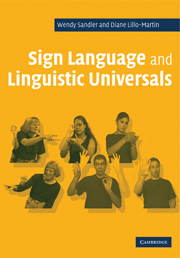Preface
Published online by Cambridge University Press: 05 June 2012
Summary
Natural sign languages are clearly very similar to natural spoken languages in many significant ways. Sign languages are conventional communication systems that arise spontaneously in all deaf communities. They are acquired during childhood through normal exposure without instruction. Sign languages effectively fulfill the same social and mental functions as spoken languages, and they can even be simultaneously interpreted into and from spoken languages in real time. These basic common characteristics lead to a compelling expectation: that natural languages in the two modalities will be similar to one another from a strictly linguistic point of view as well, in both content and organization.
But how similar are sign languages and spoken languages really? When we attempt to describe and analyze morphology, syntax, and phonology in sign language, are we wandering in the realm of metaphor? Or are we traveling in familiar territory? By “sign language phonology,” for example, do we only mean that sign languages have a taxonomy of formational components? Or do we really mean they have a finite set of meaningless contrastive units that combine in constrained ways to form meaningful morphemes and words, and that the mental representations of these lexical items may differ predictably and discretely from their actual realization? The difference between the latter characterization and the former is the difference between metaphorical analogy with spoken language phonology and concrete comparison. More than that, the latter characterization describes a linguistic system and the former, well, almost anything.
Information
- Type
- Chapter
- Information
- Sign Language and Linguistic Universals , pp. xv - xixPublisher: Cambridge University PressPrint publication year: 2006
